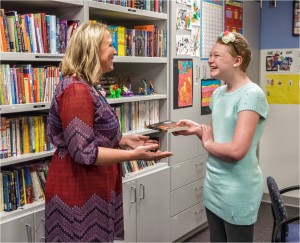Thanks to the hospital school, Brighton Smith learned to believe in herself again after cancer robbed her of her confidence. Help us celebrate the teachers who shine the light of learning – and personal growth – into the dark corners of illness. GiveBIG to Seattle Children’s on May 5 (GiveBIG and National Teacher Day). The Seattle Foundation along with a generous anonymous donor will help you stretch your gift by matching donations dollar-for-dollar, up to $10,000. Your generosity provides concrete resources like laptops and textbooks for the hospital schoolroom.

Brighton Smith didn’t feel well. Several weeks of battling chills and fatigue had left the 11-year-old wanting to sleep all the time. Her mom, Cassia Smith, worried she might have mono or even be depressed. Then a trip to her primary care provider yielded a very scary turn of events: a referral to Seattle Children’s and a diagnosis of leukemia – all in the same day.
Once on the Cancer Care Unit, everything but Brighton’s treatment fell by the wayside; that’s when Lisa Schab, a middle-school teacher from Seattle Children’s School Services, dropped by Brighton’s hospital room.
“School?” Smith remembers thinking. “With such a life-changing and consuming event as our daughter’s cancer diagnosis, we completely forgot about education. Miss Lisa helped us see that even a life-threatening diagnosis didn’t have to stand in the way of Brighton’s learning.”
Each year, more than 1,300 children like Brighton attend Seattle Children’s Hospital Schoolroom, where seven state-certified teachers and an aide provide classroom learning and bedside tutoring to support academic success. Lessons are tailored to each child’s medical needs and coordinated with each child’s school back home to ensure a smooth transition when they get out of the hospital. While the school is free to patients who are in the hospital more than five days, it is not without cost and it is not covered by a patient’s insurance. Washington state covers 40% of the cost, and Seattle Children’s and generous donors pay the remaining 60%.
Making the abnormal normal
At first, Brighton didn’t want to attend the school. The stress of the hospital experience – losing her familiar routine, being separated from her dad and siblings (who had to stay home in Oak Harbor, Wash., for work and school), and never knowing how sick she would be from day to day – escalated her anxiety and made her terrified to be apart from her mom.
“I had a lot of stupid worries when I was in the hospital,” confides Brighton, now 13. “I thought I might forget who I was. Then I worried I’d forget who my family was. And when we started talking to Miss Lisa about school, I got really scared something would happen to my mom and she wouldn’t come back for me.”
For Schab, welcoming kids like Brighton where they’re at – fearful, sad, angry, no hair, IV pole, pajamas – is one of the parts of her job she loves most. She’s proud that the school is not a study hall, but a one-room schoolhouse where academics and enrichment activities like creative writing and philosophy are taught in a safe, nonjudgmental and nonmedical space.
“You’d think patients wouldn’t come back when I give them homework, but it’s just the opposite,” says Schab, a veteran teacher who has worked with fourth- to eighth-grade students at the hospital school for nearly 15 years. “All of a sudden, they have a schedule and assignments that are similar to what their peers at home are doing. The school offers fun things to look forward to and it’s an emotional outlet away from the bedside. It provides a real sense of normalcy and connection.”
Blooming where planted
Brighton started slow. At first, her mom came to the hospital schoolroom with her and sat on a couch in the background. They’d stay for two minutes and leave. Next, Schab gave Brighton a sparkly blue stress ball and told her to squeeze it whenever she felt anxious – it helped extend the time Brighton could stay before she felt panicky.
Then Brighton made friends.
“The next thing I knew, she was saying ‘bye, mom,’ and heading into the classroom by herself,” laughs Smith. “I was so relieved Miss Lisa knew what to do. She really helped us manage Brighton’s anxiety by being consistent and keeping her busy – Brighton would even ask for extra homework! When everything else was so unpredictable, the school was the one thing we could count on. We both relied on it to keep our sanity.”
Brighton agrees and says without school she would have been bored. “My best friend in class had a heart transplant and we liked to make plans to hang out together,” she remembers. “I also learned to love poetry and when it was time to go back to my regular school, I didn’t have anxiety about that.”
9-1-1 for learning
“Educational first responders” is how Brian Ross, who leads the school program, describes his team. “We’re the first teachers to work with kids after a significant injury or illness.”
Ross says the most important work his team does is to help students believe in themselves again and rebuild the confidence that long hospital stays can steal. “Given care, compassion and creativity, children are remarkably resilient and can overcome barriers that seem insurmountable to most of us,” he explains.
Smith is grateful. Brighton grew and blossomed, even as she went through nearly a year of treatment. For the same two hours every day at the hospital school, her daughter had hope for the future – and Smith believes that was one of the most healing elements of all.
GiveBIG now to help support Seattle Children’s Hospital Schoolroom.

